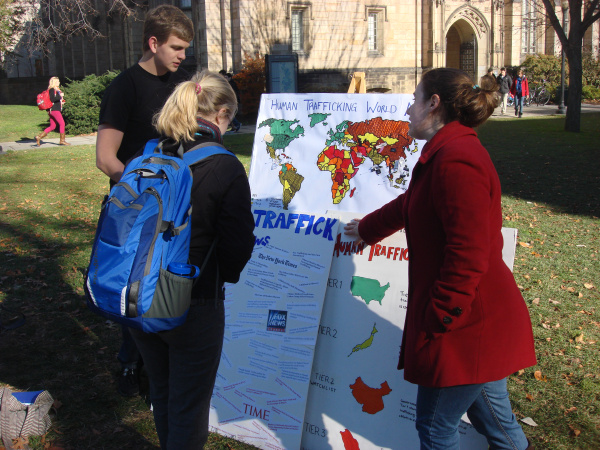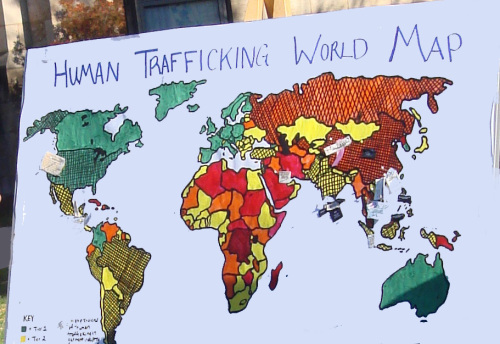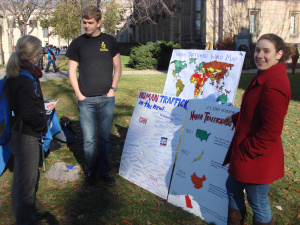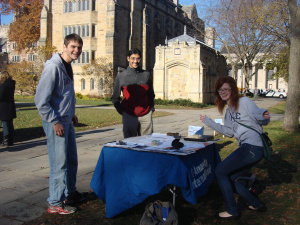by Katy Naples-Mitchell, Co-Coordinator
“Every time you spend money, you’re casting a vote for the kind of world you want.” – Anna Lappé
Human trafficking is a multi-billion dollar industry; it leaves few corners of the world untouched. Experts estimate that 27 million people are trafficked annually. And yet it is rare that we think about how our actions as consumers may contribute to the enslavement of others.
Raising Awareness on Cross Campus
On Wednesday, November 14, Yale Amnesty International undertook an awareness raising event about human trafficking on Yale’s Cross Campus. After months of brainstorming and weeks of preparations, our plans had finally come together. The premise behind the event was to find a way to demonstrate the global reach of trafficking as well as to encourage individuals to consider their individual impacts. We chose to focus on the garment industry because it’s something that pretty universally affects us—as most people we know tend to own and wear clothing.

Making Our Idea a Reality
The initial vision for this event was hazy at best. We wanted to have a world map which people would pin their clothing tags on, and then we could give them information about what kind of trafficking patterns or documented cases of trafficking might exist in the country in which their clothing was made. Since trafficking is an immense criminal industry, statistics on the number of trafficking cases or victims in a particular country are hard to come by. The United Nations Office on Drugs and Crime, the body charged with governing the UN Convention against Transnational Organized Crime, including the Protocol to Prevent, Suppress and Punish Trafficking in Persons, puts together reports semi-annually which qualitatively describe countries’ trafficking patterns.
But in putting together a visual representation of countries and human trafficking, we needed a much more quantitative measure, one in which countries were ranked relative to one another. This meant we relied upon the U.S. State Department’s Trafficking in Persons (TIP) Report, published annually in June.
TIP Report Rankings

The TIP Report ranks countries according to whether their governments have taken proactive steps to prevent, punish, and prosecute human trafficking. The report categorizes countries into three distinct tiers. From the State Department website:
TIER 1
Countries whose governments fully comply with the Trafficking Victims Protection Act’s (TVPA) minimum standards.
TIER 2
Countries whose governments do not fully comply with the TVPA’s minimum standards, but are making significant efforts to bring themselves into compliance with those standards.
TIER 2 WATCH LIST
Countries whose governments do not fully comply with the TVPA’s minimum standards, but are making significant efforts to bring themselves into compliance with those standards AND:
a) The absolute number of victims of severe forms of trafficking is very significant or is significantly increasing;
b) There is a failure to provide evidence of increasing efforts to combat severe forms of trafficking in persons from the previous year; or
c) The determination that a country is making significant efforts to bring itself into compliance with minimum standards was based on commitments by the country to take additional future steps over the next year.
TIER 3
Countries whose governments do not fully comply with the minimum standards and are not making significant efforts to do so.
Our Map
We printed a large map and hand-painted it according to colors associated with each TIP Report ranking.
Tier 1 = green
Tier 2 = yellow
Tier 2WL = orange
Tier 3 = red

We also cross-hatched 21 countries based on a list we compiled of countries that have documented cases of trafficking in the garment industry, notable sweatshops from major companies, or produce raw materials that are linked to trafficking and exploitative labor conditions. This was our effort to combat the impression the TIP Report rankings give that the Western World (and Global North) have exclusively better standards than other parts of the globe.
The cross-hatched list traversed all ranks of the trafficking Tiers, demonstrating that just because a country may punish trafficking severely and take policy steps to combat it does not mean that said country is free of trafficking or exploitative labor practices and companies that rely on slave labor in their supply chains. We then attached the finished map to a corkboard so we could pin people’s tags directly to the map.
Action Opportunities
We asked passersby to cut out a tag from something they were wearing, pin it on the map, and then together with our members, figure out what that might mean. Here were our results.
Countries Represented by Tags on the Map
(listed roughly from East to West and North to South, to go along with the map)
| Country Name | Number of Tags | Tier Placement | Crosshatched for Garment Trafficking? |
| USA | 1 | 1 | Yes |
| Haiti | 1 | 2WL | No |
| Gautemala | 2 | 2 | No |
| Honduras | 4 | 2 | Yes |
| Nicaragua | 1 | 1 | No |
| Qatar | 1 | 2 | No |
| India | 5 | 2 | Yes |
| China | 8 | 2WL | Yes |
| Bangladesh | 1 | 2 | No |
| Thailand | 1 | 2WL | Yes |
| Philippines | 1 | 2 | Yes |
| Malaysia | 1 | 2WL | Yes |
| Indonesia | 2 | 2 | Yes |
| Cambodia | 2 | 2 | Yes |
| Vietnam | 2 | 2 | Yes |
| Hong Kong | 2 | 2 | No |
Of the tags we had, 10 out of 16 (62.5% of) countries represented had been crosshatched for trafficking. Moreover, adjusted for the proportion of tags from each country, 77% of the tags on the map came from countries that have high rates of trafficking in the garment industry. This is not a statistically representative pool and there are certainly problems with our methodology, but it was random and does make for a pretty startling representation of our habits as consumers.
We also had a petition on hand, directed at Forever 21’s headquarters. Forever 21 has a reputation of sourcing most of its cotton from Uzbekistan, where there have been documented cases of forced child labor in the cotton picking industry. Additionally, Forever 21 has been accused of sweatshop conditions in its manufacturing. We wrote a letter to Forever 21, in tandem with the existing change.org petition hyperlinked above, calling on the executives of the company to make sure that there was no slavery in their supply chain going forward. This petition has particular traction for students of our age demographic, since the store targets us as its primary consumers. During the course of the day, we gathered 118 signatures! For more information on trafficking and exploitation in the garment industry, check out the Clean Clothes Campaign, the largest alliance of labor unions and NGOs in the garment industry.
We had takeaway materials on hand to give away to those who wanted more information or didn’t have time to stop at the table. We compiled a Human Trafficking Fact Sheet as well as a “Watch What You Wear” Country Breakdown, which you can view for yourself by clicking on the links.
Check out some photos from the day’s activities below. To see an enlarged version of the image, simply click on it.




Reservations & Reflections
As a few passersby pointed out during our demonstration, and as we were concerned about in preparing the map, using a ranking based on legality and government steps taken to address trafficking created a visual representation that, if mistaken for being a visual representation of trafficking in the world, would be extremely misleading and particularly damning and damaging to the Global South. This was not our intention, and we do regret having contributed to any misconceptions that seem to exempt the countries in Tier 1 from the presence of trafficking. For the purposes of creating a map this coloring scheme was the best we could come up with—and so perhaps this brings to light the real need for further research into global trafficking streams and hard data on the extent to which trafficking happens within each country in the world.
Have feedback for us? Interested in hearing more about any aspect of our efforts to raise awareness about trafficking? Give us a shout in the comments below! And as always, thanks for reading.